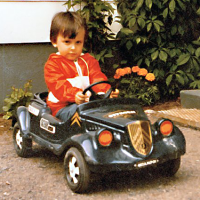Where it all starts
Sometimes I find myself thinking of stuff I should not be bothered with. The most recent time this happened was when I saw this GIF showing a simulation of what happens when a star is consumed by a black hole (it looks marvelous, I'd say)Well, this got my mind working... Black holes are not some gigantic vacuum cleaners in the sky preying on unsuspecting stars to consume. In fact - for the black hole to have any kind of effect on the trajectory of a star in the first place, the black hole would need to have a mass comparable with the star, which something that is a way lot more than most people are even able to visualize in their mind.
The experiment
For the sake of satisfying our scientific hunger, let us create a lab room for testing things with black holes. The room is created in such a fashion that no amount of gravity escapes from the room (thus making it safe to test some serious shit inside the lab) ... for the sake of argument, let's do this by magic, since I know of no way to actually achieve it otherwise.Now, let us put a black hole in the middle of the room that has a mass of one million metric tons. And since we are sadistic beasts that couldn't care less what PETA has to say, let us put a mouse inside the lab and see what is going to happen to the mouse?
This is going to be legen-(wait for it)-dary!
Aaaaand... absolutely nothing. Wait? NOTHING you say?!? Yes, the mouse is unharmed. As is the lab assistant that went to the room to put the mouse in there. Even me, the mad scientist performing this experiment that entered the room to see what went wrong is completely unharmed.The "mad scientist"-me is furious. Why did the experiment fail? Did our magnificent black hole escape the room before we started?
Interestingly, the answer is that the experiment didn't fail - it simply proved that black holes behave exactly the way they are supposed to, and that you still need to obey gravity (after all, it's the law; don't mess with it).
So, what went "wrong"?
Inverse square rule of gravity effect and a huge misunderstanding of mass and other things required to make anything happen. To put it simply - believe it or not, a black hole with a mass of one million metric tons is way smaller than an atom. The inverse square rule of gravity states that every time the distance from the object doubles, the gravitational effect of the object drops to one fourth. And, since the object in question is smaller than an atom, the drop in gravitational effect happens fast.In fact, were the mad scientist to go stand in the middle of the room, chances are that still nothing would happen. There are vast amounts of "empty space" between atoms, and for even one atom to come close enough to the black hole to be consumed by it, that atom would have to be extremely unlucky - and that is where the train would stop; you'd be that one atom short in your body and would never be able to tell the difference.
Why are black holes usually depicted as "starkillers" then?
Well, our experimental black hole was too small to do anything. That doesn't mean that there aren't far larger ones to be found in the universe - there are. Interestingly, though. For a black hole to have any kind of effect, it usually needs to be huge (and by "huge" I really do mean bigger than massive ... our one million metric ton black hole just wasn't large enough, not by a far margin).Let's take something a bit more sinister; a black hole with a mass of one sextillion (that is a number with one followed by 21 zeroes) metric tons. That would be roughly one sixth the mass of earth and if one were passing through the solar system it could have an impact on the orbits of the planets. Still however the chances are that such an object would pass through the solar system completely unnoticed. Interestingly - if that black hole were to pass by earth at a suitable velocity and distance, there are bigger chances that earth would make a satellite of it ... it has about the same amount of mass as our moon (and what a great opportunity for science that would be having our own largeish black hole to experiment with).
That "moon mass" black hole would still frankly be quite small. So let's go mythbusters and ramp things up a little - say... get a black hole 2 million times larger than the previous one. The mass of that thing would be roughly similar to the mass of sun. This means that if earth were directly in the middle between the sun and our black hole, we would possibly finally become the center of our solar system; sun and the black hole would start to revolve around each other with the earth stationary in the middle. Most likely all the other planets in the solar system would have a hard time to adapt to the situation, though.

